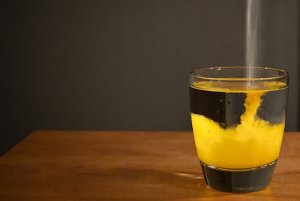
Swirling a Fluid from Within
From churning rapids to Vincent van Gogh’s Starry Night, there is something about swirling motions that draws people in. The same can’t be said for the large, imposing structures that make up industrial chemical reactors found in water treatment centers and manufacturing plants. However, in some ways the two are closely connected.
Pour some powder into a glass of water and the result is a chaotic swirling motion that carries the grains down the length of the container before they settle on the bottom. Although beautiful, this type of swirling can negatively influence the performance of chemical reactors that rely on powders suspended in a fluid. In a research paper that will be published this week in the American Physical Society’s journal Physical Review Letters, scientists from Israel and the United States provide new insight on how to control this swirling.
One of the attendees was Haim Diamant, a scientist from Tel Aviv University who was equally fascinated by the process. Witten and Diamant teamed up to study the physics behind this twisting with a grant from the US-Israel Binational Science Foundation.
They worked on the project remotely, and Diamant and his then-PhD student Tomer Goldfriend spent a week visiting Witten at the University of Chicago one summer. “We three theorists lost our heads and tried to make an experiment…here we were, scrambling around on Friday afternoon before their flight left, sticking rulers in our water tank and trying to capture the motion of the twisting objects with our cell phones. We kept making mistakes and breaking up laughing” recalls Witten. The collaboration and friendship continued.
Last year, the team realized that the same phenomena responsible for twisting a single asymmetric object along its descent could help control the swirling, chaotic motion that occurs as many particles make their way through a fluid at the same time, a process called sedimentation. Because this motion is the result of how individual particles interact with the fluid, each other, and the walls of the container, it has traditionally been very difficult to predict and control.
Previous research has shown that the swirling caused by sedimentation is due to variations in the weights and speeds of particles. Heavy grains travel faster and draw water downward, causing the water to churn. This causes even symmetrical objects, like spheres, to rotate as they fall.
In this new research, the team explored how the swirling impacts sedimenting objects that are not symmetrical—objects that align themselves with gravity in a way that depends on their shape and distribution of mass. The researchers explored this case theoretically, using mathematical models, but their results can be experimentally tested and hopefully will be soon.
The model predicts that asymmetrical objects do not rotate under the swirling, they tilt. This tilting causes them to glide sideways as they fall. In turn, this sideways motion affects the way that the particles and their velocities are distributed within the container. Some shapes reduce the swirling and lead to a more uniform distribution of particles while other shapes enhance swirling and an uneven distribution.
The exact outcome depends on the gravitational force on the objects, size of the objects, average concentration of objects, viscosity of the fluid, and speed with which shapes align with gravity. There are many factors, but this research provides a framework for predicting how a powder (or other granular material) will behave under different circumstances. It also opens the door to incorporating carefully chosen shapes into a powder in order to control swirl. This could be a new method for optimizing the performance of a chemical reactor. Perhaps it will be used to create some beautiful art as well.
View original article
